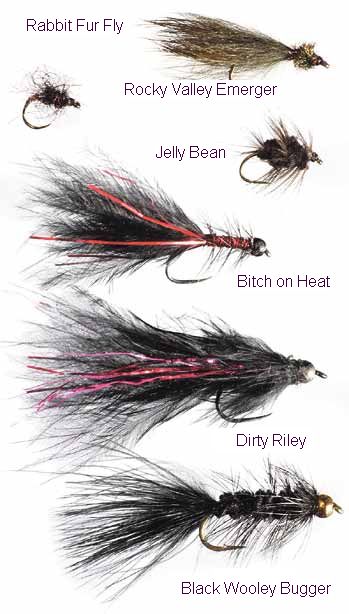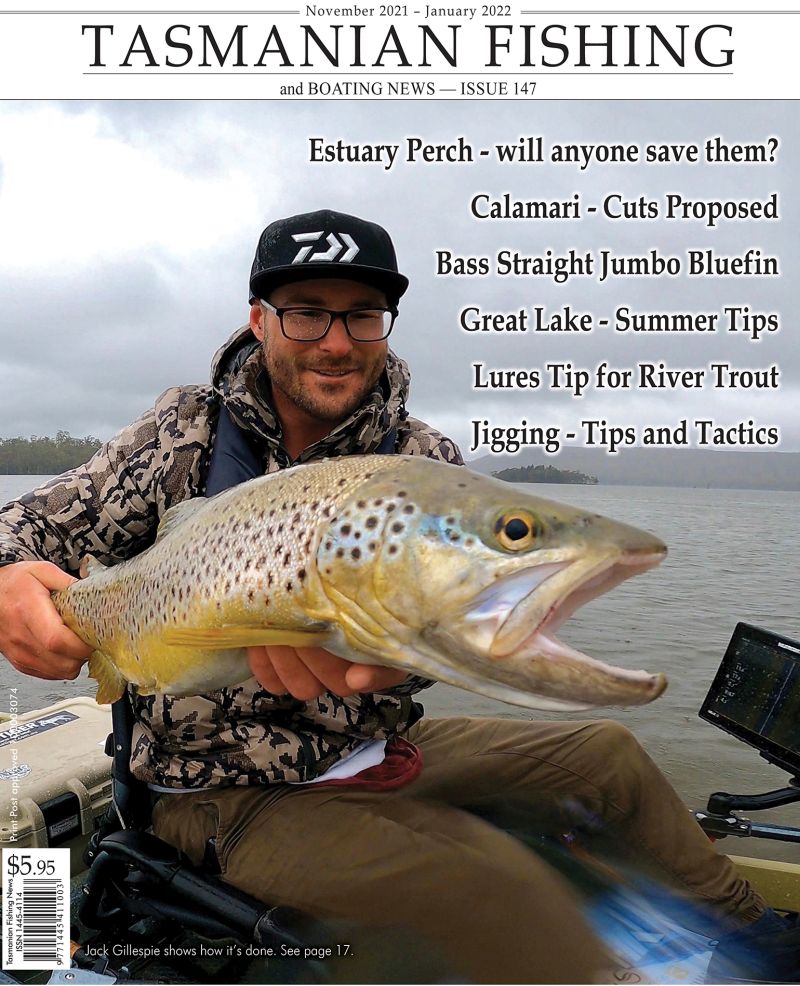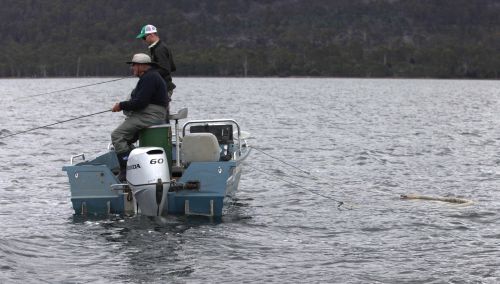 Presented from Issue 99
Presented from Issue 99
The early trout season is always a special time. High water levels with brown trout foraging for a meal close to the edges giving anglers a keenly awaited opportunity for sight fishing, hunting a moving quarry in the shallows as it pushes a bow wave or sends the tip of its tail through the surface as it picks up a morsel off the bottom.
There have been many developments with fly tying materials in recent years, a fly fishing shop contains more glitter and colour than a mardi gras in the fly tying section, but sometimes basic old fashioned patterns which have stood the test of time are the requirement for successful fishing. Flies that are basic in concept and design, simple but representative of life in basic dull natural colours.
These flies are most effective when ‘hunting’ moving fish because you can place them in the view of a trout with an effective, accurate cast. There is no need for flash or fast pulling a fly to get the attention of a trout, the accuracy of a well placed cast with and a gentle plop as the fly hits the water and settles in the anticipated path of the trout will generally do the job. If there is no response then only a little twitch or draw of a few inches to ensure salmo sees his meal.
 Rabbit Fur Fly
Rabbit Fur Fly
Every Tasmanian fly fisherman’s fly box should contain the rabbit fur fly, this simple pattern is a must for foraging trout. The fur fly is best in very low light and when trout are moving actively foraging around tussocks and newly covered ground. The marshes around Four Springs Lake, Bronte Lakes, Huntsman Lake, Nineteen Lagoons are all good waters for the fur fly.
The approach I use is to place the fly close to the trout, in very low light put it near to him so that the fall of the fly on the water is sensed, just give a slow draw on the fly then judge for a take by the swirl as the trout turns on the fly, watch carefully the leader for any sign of a draw or resistance to the natural movement as this is the clue that the fly has been mouthed. Sometimes you have to make a judgement call, striking on the swirl. This is always exciting to me, the impending success with the trout panicking as the hook is driven home, either somersaulting out of the water or taking off with leader in tow and a good bend in the rod. Of course fairly regularly when you guess, the result is the fly flicking up to the sky and a big bow wave as the trout heads back to the safety of deeper water, spooked for now but likely to return to the food in the shallows.
The fly is simple, as so often is the case with the tried and true patterns. Rabbit fur tied around the shank of a wet fly hook, with a head of peacock hurl or coloured tying silk. Black, dark olive or natural rabbit fur are all effective, peacock hurl or a yellow tying silk head to give some hot spot or semblance of stick caddis will give a more than effective selection of fur flies. Sizes from 8 to as small as 14 will cover a good size range.
Jelly Bean
This simple snail pattern was shown to me by Gary ‘Hairy’ Castles sometime around 1987, when I was living in Victoria and used to visit the Central Highlands for a weekly trip twice a year. This fly is a great pattern for tailing trout, not just foraging fish but also for those ‘grazers’ feeding on scud and snail, Hairy showed it to me for using for trailers on Little Pine and in the Western Lakes. This fly is basically a snail pattern and is good for those grazing fish and for use in brighter lights conditions when no movement of the fly is necessary. The jelly bean is also a good pattern for wade polaroiding early in the season, when trout will not rise to a dry fly. Trout will pick it off as it slowly sinks once presented to them. This is where real judgement is required, where the cue to an acceptance of the fly may be a flash of white from his mouth, a flaring of the pectoral fins or a sudden bend of the flank of the trout as he rushes to the fly and the stops as he engulfs it.
I tie the jelly bean on a size 12 to 16 hook. It is black chenille wrapped for two or three turns forward from the rear where it is tied in with some monofilament or fine wire for a rib. Once the chenille is wrapped forward a black hen hackle is stripped on one side and then tied in at the head. It is then palmered lightly through the fly with about 3 to 4 turns, trapped in with the rib which is wound forward to the eye of the hook. The tip of the hackle feather can be left intact to give a realistic tadpole appearance, however I have always nipped it off. A very simple fly, but super effective fished stationary to tailing trout.
Black Woolly Bugger
If there’s a colour for early season it’s black. Whilst black is effective all year, it seems to be most effective early and late in the season. The Woolly Bugger really is about as versatile a wet fly as you can get, there are so many variations combinations, and everyone has their favourites. Woolly Buggers work best when they have a bead head and a long marabou tail, the reason is simple; the weight at the front causes the tail to swim seductively giving a great facsimile of life. Some anglers are reluctant to fish woolly buggers with long tails, fearing or claiming that trout ‘take short’ or ‘nip at the fly’. Trout don’t nip at woolly buggers, trout are predators and when they attack larger food items they engulf their prey, even a small trout can swallow a size 8 woolly bugger. Having done a great deal of experimenting with line control in wet fly fishing, most missed takes are attributable to the amount of slack line an angler has when blind fishing wet flies. The more slack, the later and softer take detection is, the resultant failure to hook up is put down to the trout not really wanting the fly and nipping at it. Removing most of the slack from the retrieve and being in. Good contact results in the feeling of strong to savage takes and a good hook up rate, the issue is more of a question of technique rather than disinterest or suspicion by the trout about the fly.
Here’s some more black based Woolly Bugger patterns which are effective: Dirty Harry: A traditional black Woolly Bugger, chenille body palmered with a hackle, a long black tail with strands of pearl flash the length of the tail. Dirty Riley: Similar to, but not really a true Woolly Bugger, it has a long black marabou tail with strands of fuchsia axel flash incorporated into it, a body which is also made of short black marabou tied on in tufts which go back to the start of the tail. The whole fly is basically marabou which gives mobility and the fuchsia flash which works a treat.
Bitch on Heat:
This is a black tailed Woolly Bugger pattern with red flash incorporated in the tail, a red tinsel body with a palmered black hackle over it. When this fly works it works a treat, however it’s usually feast or famine and when it will work does not always discernible.
Rocky Valley Emerger
The last fly doesn’t have a name as such but it is a fantastic dry fly for rivers and lakes when trout are consistently sipping food from the surface. I was shown a version of this fly by a friend for Rocky Valley Lake at Falls Creek in Victoria when trout were midging, hence it’s been dubbed the Rocky Valley Emerger. Like most good flies it is quite simple but is made most effective by the fact it is so simple.
I only tie this fly on size 16 and 18 grub hooks. The fly is pearl mylar wrapped up the shank from the bottom portion of the hook and then is a rough body of dubbed black seals fur, basically a blob on the top 1/3rd of the hook. This fly accepts floatant really well and sits low in the surface film of the water.
It is an ideal patterns for trout in the rivers when they are feeding on caenids or just consistently sipping on ‘stuff’ which you can’t quite work out. This fly has saved the day for me more times than I can remember in situations like I’ve described, when the trout are feeding on caenids on the Macquarie and South Esk, early morning, this fly is my number one option.
The fly is fished on a very long leader with fine, 0.10 to 0.12 tippet. You have to be able to cast accurately to trout sipping in the surface as being so close to the surface they have a limited field of vision. Although the pattern is much bigger than the natural caenids, I think it has the same appearance as a midge ball, giving an impression of a clump of flies joined together in the surface film. Regardless of the reason, trout generally don’t hesitate to accept this offering when presented properly.
One other thing about this fly, even if it sinks slightly below the surface it will still be accepted. Watch the fly, however if you can’t see the fly just watch the tippet and look for a tell tale draw on the leader or a swirl where the fly should be, then strike after an appropriate momentary pause.
All of these flies are simple effective patterns, they are dull in colour, somewhat like the early season conditions we fish in. They are tried and proven. The only relative new comer, the Rocky Valley Emerger has a pedigree of its own having caught trout for me in different States, Countries and Continents as well as on lakes and rivers in Tasmania. They are flies than can be fished with confidence in a wide variety of conditions and situations, enough to cover most early season situations.
Joe Riley




